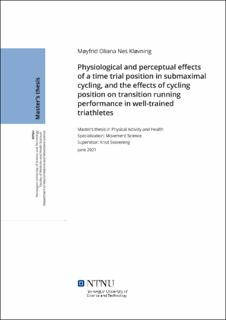| dc.contributor.advisor | Skovereng, Knut | |
| dc.contributor.author | Kløvning, Møyfrid | |
| dc.date.accessioned | 2021-09-25T16:30:51Z | |
| dc.date.available | 2021-09-25T16:30:51Z | |
| dc.date.issued | 2021 | |
| dc.identifier | no.ntnu:inspera:82525395:11767632 | |
| dc.identifier.uri | https://hdl.handle.net/11250/2783225 | |
| dc.description.abstract | Oppsummering
Introduksjon: Tempostilling (TTP) benyttes hyppig av triatleter for å redusere luftmotstand under sykling. Det er mulig at TTP medfører fysiologiske og perseptuelle endringer som kan påvirke sykkel- og påfølgende løpsprestasjon. Målet med denne studien var derfor å undersøke hvordan TTP påvirker fysiologiske og perseptuelle variabler under sykling sammenlignet med en oppreist sittestilling (UP), og i tillegg om det er forskjeller i hvordan TTP og UP påvirker påfølgende overgangsløpsprestasjon hos godt trente triatleter.
Metode: Etter en dag med grunntesting (laktatprofil og VO2max) utførte 12 godt trente triatleter en 60 min sykkelprotokoll innledet av en 15 min periode med en trinnvis økning i belastning fra 50-80% laktatterskel (LT) etterfulgt av 45 min med drag på 80, 95 og 105% av LT før en direkte overgang til en 5km løpstest. Protokollen ble utført en gang i TTP og en gang i UP på to separate dager atskilt med minimum 48 timer. Laktat, kardiopulmonale variabler, lokal oksygenmetning og opplevd anstrengelse ble målt.
Resultater: Fysiologisk og perseptuell kostnad ved sykling økte i TTP sammenlignet med UP. Dette inkluderte en signifikant økning av laktat (95% LT: ↑1.2 ± 1.6 mmol/L; 105 LT: ↑1.3 ± 1.7 mmol/L), hjertefrekvens (95% LT: ↑4.4 ± 5.2 bpm; 105% LT: ↑5.1 ± 6.9 bpm), pustefrekvens (105% LT: ↑3.4 ± 5.3), minuttventilasjon (95% LT: ↑9.9 ± 13.6 L/min; 105% LT: ↑9.9 ± 13.9L/min) og opplevd anstrengelse (105% LT: ↑1.9 ± 1.2 A.U). Lokal oksygenmetning ble signifikant påvirket av posisjon i tibialis anterior (↓) og gastrocnemius (↑). Under løpstesten var hjertefrekvens signifikant lavere etter TTP sammenlignet med UP. Det var ingen signifikante forskjeller i den totale tiden brukt på 5km løp mellom sittestillingene på sykkel.
Konklusjon: Denne studien viser en økt fysiologisk og perseptuell kostnad ved bruk av TTP sammenlignet med en UP under sykling. Løpsprestasjon direkte etter sykling påvirkes dog ikke av sykkelposisjonene som er undersøkt i denne studien. Sett i lys av eksisterende litteratur vil mulige negative prestasjonseffekter ved bruk av TTP sannsynligvis utlignes av den aerodynamiske fordelen ved å benytte TTP. | |
| dc.description.abstract | Abstract
Introduction: A time trial position (TTP) is commonly used among triathletes to reduce air drag during cycling, possibly leading to alterations in physiological and perceptual variables that could affect cycling- and subsequent running performance. The aim of this study was to investigate how TTP affects physiological and perceptual performance variables during cycling compared to an upright position (UP), and in addition how TTP and UP differ in affecting subsequent transition running performance in well-trained triathletes.
Method: After a day of baseline testing (lactate profile and VO2max), 12 well-trained triathletes performed a 60 min cycling protocol initiated by a 15 min ramp up from 50-80% LT, followed by 45 min of bouts at 80, 95 and 105% LT before going straight into a 5km transition run. The protocol was performed once in a TTP and an UP on two separate days separated by a minimum of 48h. Lactate, cardiopulmonary variables, local oxygen saturation and perceived exertion were measured.
Results: Physiological and perceptual cost of cycling increased in the TTP compared to the UP. This included a significant increase of lactate (95% LT: ↑1.2 ± 1.6 mmol/L; 105 LT: ↑1.3 ± 1.7 mmol/L), heart rate (95% LT: ↑4.4 ± 5.2 bpm; 105% LT: ↑5.1 ± 6.9 bpm), breathing frequency (105% LT: ↑3.4 ± 5.3), minute ventilation (95% LT: ↑9.9 ± 13.6 L/min; 105% LT: ↑ 9.9 ± 13.9 L/min) and perceived exertion (105% LT: ↑1.9 ± 1.2 A.U). Muscle oxygen saturation was significantly affected by position in the tibialis anterior (↓) and gastrocnemius (↑) muscles. In the 5km transition run, HR was the only variable that was significantly affected by position, revealing a lower HR during the run after the TTP compared with the run after the UP, however, the total time spent on a 5km run was not significantly affected by position.
Conclusion: The present study demonstrates that there is an increased physiological and perceptual cost of cycling in a TTP compared to an UP. Transition running performance was not significantly affected. Seen in light of existing literature, the potential negative performance effects of using a TTP would most likely be outweighed by the aerodynamic benefit of the position. | |
| dc.language | eng | |
| dc.publisher | NTNU | |
| dc.title | Physiological and perceptual effects of a time trial position in submaximal cycling, and the effects of cycling position on transition running performance in well-trained triathletes | |
| dc.type | Master thesis | |
